



| <-- Previous | LMHS Home | Contents | Order Book | Next --> |
The Rise and Fall of the Mills. The largest waterway running through Lower Merion Township is Mill Creek, a source that bubbles up in Villanova, runs southeast through Bryn Mawr, spills into Dove Lake in Gladwyne, and then proceeds over various falls until it links with a tributary just east of Ardmore. There it turns sharply eastward, and with new replenishment meanders through the lush Mill Creek Valley, separating Penn Valley and Gladwyne, until it empties into the Schuylkill River at Flat Rock Park. For over two hundred years the power of the water in Mill Creek fostered mill industries unmatched anywhere in the Township. The many different mills supplied both local residents and Philadelphians with grain, paper and cardboard, guns and gun powder, lumber, sheet metal, woolen fabric, cotton and woolen threads, and candle and lamp wick.
The paper produced by the mills served for America’s earliest documents, currency, and cartridge paper and can be identified by watermarks in archives throughout the country. At least twenty different mill sites along the creek have been identified by documents, standing buildings, ruins, or archaeological remains. For each one a mill pond, dam, raceway, sluices and mill buildings, wheel houses, and intricate mechanisms had to be constructed and maintained by owners and workers. Mill Creek Valley was a bustling industrial site through much of the 19th century. Mill ownership expanded beyond the original Welsh settlers to include families from Germany, Switzerland, and England.
Certain mills, such as paper, grist, and saw mills became uneconomical by the 1850s due to advancing technologies. These closed or were converted to textile mills. More influential in changing the industries was the power of the water that drove the wheels, stampers, mill stones, saws or spindles. It had devastating effects when uncontrolled. Storms and floods frequently destroyed dams and mills, wiping out entire businesses. The flood of 1893 brought the final destruction of most remaining mills on the creek. The one exception was the former Nippes gun factory that had been converted to the Barker Woolen Mill. With a conversion to a water turbine, this mill produced woolen thread into the 1950s and still stands.
Maps and advertisements tell us that at least a textile and paper company retained their land and warehouses into the second decade of the 20th century. But by then Mill Creek Valley had begun to shift from an active mill community with worker tenements, small, stuccoed twin homes, a store and post office at Rose Glen, and the neighboring Reading Railroad line to a quieter, suburban residential community.
As industry moved elsewhere, properties were purchased by wealthy financiers and industrialists for suburban living. New homes were built by turn-of-the-century architects on the hilltops. Mill structures, mill owners’ homes, and modest workers’ housing were converted into serviceable residences for staff.
In the 1920s, for example, James Crosby Brown’s estate grew to 185 acres of former industrial land. After Brown’s death in 1930, the restricted and sensitive development of his estate into three acre lots helped protect the natural environment and established minimal and compatible new residences in Mill Creek Valley. More recent protection has come through Lower Merion Township’s purchase in 1994 of Walter C. Pew’s 103-acre estate to create Rolling Hill Park. Within this natural parkland, stone building ruins along the waterway remain as architectural testament to Lower Merion’s industrial past.
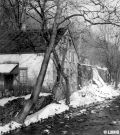
Croft Kettle Mill on the Mill Creek and Old Gulph Roads corner. The mill was built in 1840 and is seen here during its use as a residence in the early 20th century.

Samples of watermarks found in papers made by the papermakers of Mill Creek. Watermarks were symbols, names or initials used to identify the manufacturer, the type of paper, or the person for whom it was made. They are visible in fine papers when a sheet is held up to the light.
Drawings by John M. Nugent.
Roberts Mill. On Old Gulph Road in Gladwyne, where Mill Creek spills over a natural fall, John Roberts III built a grain mill in 1746. Measuring 28 by 40 feet, it presumably stood on the site selected by his grandfather, John Roberts, for "The Wain," the first mill established for the Welsh settlers of the area after their arrival in 1683. What remains of the historic Roberts mill at the millenium is merely the east end wall. But the lintel over a filled-in doorway still bears the faint inscription "J & JR 1746."
John Roberts III of Lower Merion and Jane Downing of East Caln Township in Chester County married at a Quaker public meeting at Uwchlan on the first day of the fourth month of 1743. Their years of success in marriage and business is marked by the birth of 12 children between 1743 and 1768 and the growth of John Roberts’ land holdings along Mill Creek to the Schuylkill. By 1774 these amounted to 420 acres, and taxation that year was on one grist and saw mill and one paper mill.
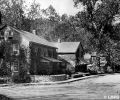
These small stone vernacular buildings neighboring Roberts Mill and residence, constitute the purest 18th century architecture derived from Welsh traditions that remains in the Township. In 1980 they became part of the Mill Creek National Register Historic District.
To accommodate his family, in 1752 he built a large, stone addition in a typical Welsh architectural tradition to the existing small stone house on the hillside above the mill started by his grandfather. The Revolution and Roberts’ role as a Quaker pacifist brought the flourishing career and life of this wealthy citizen to a sad end in November 1778. Roberts was tried and hanged for treason in Philadelphia, having been accused of assisting General Howe’s army. His mill sites were confiscated and sold to new owners, but they established the industrial network for another 100 years of milling on the creek.
Conrad Scheetz. The earliest Lower Merion mill noted on a map is labeled the "Schultz Mill," which appears on the 1750 Scull and Heap Plan of the City and Environs of Philadelphia. The location northwest of Merion Meeting verifies this mill as that of the Schütz family, Protestant papermakers who settled in Germantown from Crefeld, Germany in 1733. Their name eventually became anglicized to Scheetz.
In 1748 Conrad Scheetz purchased from a Donald Davis 100 acres with an existing fulling mill (such mills processed woven or knitted woolen into a tight fabric) on Mill Creek. The site is now along Dove Lake Road, but neither the road nor the lake existed at that time.
Scheetz converted the mill to a paper mill known as the Upper Mill. His accounts with Benjamin Franklin show the purchase of rags for paper production and the sale of many types of paper to Franklin for his press. Some were personalized with watermarks bearing Franklin’s initials and symbols rather than those of the Scheetz mill.
By 1768, Scheetz had constructed a second mill downstream where a lesser quality paper was produced. It stood on the west side of the creek adjoined by a residence below where Old Gulph Road fords the stream in the vicinity of the 10 mile marker. This mill became known as the Lower Mill and it remained in the family until the end of the 19th century.
Scheetz had eight children who worked or married within the papermaking trade. Their family residence (redesigned during the Colonial Revival period), a spring house, and stone portions of a much altered barn are all that remain of the Upper Scheetz Mill today.

This ream wrapper for writing paper at the Montgomery County Historical Society depicts an image of the Dove Mill in Lower Merion. The building in the foreground with the large vertical windows is presumably the drying house. The mill building where the stampers, driven by water power, beat the cotton pulp into shreds stands to the right.
Dove Mill. The Scheetz Upper Mill took on new acclaim in 1798 when it was sold to Thomas Amies from Switzerland. He brought the name Dove Mill and the watermark of a dove to this site. Amies’ deed for the purchase of the Scheetz Mill identifies him as a cordwainer or shoemaker from Philadelphia.
Amies’ papermaking skills were presumably learned in his homeland (the Swiss produced some of the highest quality paper in Europe), and then furthered in America by a tenure at the Wilcox Ivy Mill in Chester. The watermark of a dove with an olive branch in its beak may have been derived from that mill, but for Amies it was intended to exemplify paper that could not be counterfeited.
The manufactory census of 1820 provides critical statistics on Amies’ business. He employed 12 men, 18 women, and 4 boys costing annual wages of $5,000. The fine paper produced annually had a value of $19,000. His mill investment reached $25,000 with paper stock valued at $12,000. Despite these figures that imply success, twice before Amies died (in 1849) bankruptcy was declared at his mill. Importation and industrialized papermaking processes gradually put Mill Creek’s handmade papermakers out of business.
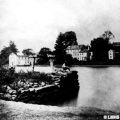
The Dove Lake Mill was
photographed by John Browne, an amateur photographer from Philadelphia,
from the west side
of the lake. The lake was formed when Samuel Croft, a new owner, dammed
the creek in 1873 for a brass rolling mill further down stream. By then
a fire had already destroyed some of the buildings, which are seen
partially flooded. Oil paintings of the mill buildings under
Croft’s ownership are exhibited in the Gladwyne Library.

In 1884, painter Thomas Eakins took a group of his students from the Pennsylvania Academy of the Fine Arts to Dove Lake where they were photographed in the nude as a scientific study for Eakins’ projected painting Swimming.

The painting of the swimmers, including Eakins and his dog, was exhibited in 1885. Within six months, Eakins was forced to resign from his prestigious position as Director of the Academy for using students as models and offending Victorian sensibilities.
Bicking’s Mill. Another German papermaker who settled in Lower Merion and established not just a paper mill but also a saw mill, a fishery on the Schuylkill, and a family cemetery was John Frederick Bicking of Winterburg, Germany. His original purchase in 1762 of a mill site upstream from the extant Barker’s Mill rapidly expanded to 255 acres, and reached the Schuylkill by 1798.
At that time he was taxed for a 40 by 50 foot mill, a 23 by 60 foot barn, a one story 24 by 30 foot stone house, a spring house, two log houses, and a cart house on pillars.
During the Revolution Bicking co-authored a petition labeled "Memorial of the Paper Makers of Philadelphia" sent to the Committee of Safety for Pennsylvania, explaining that if every man from 16 to 50 was conscripted to fill military ranks, all the paper mills on the continent would be shut down and no paper for printing offices or ammunition would be produced. The papermakers’ appeal for exemption was honored and papermakers were even called home from military service.
Bicking died in 1809 at the age of 79, and he and his family are buried in their cemetery that remains in a backyard on Fairview Road. His son David took over the mill, which prospered until his death in 1832.

Early photo (c. 1905) of Toddstown. The Mill Creek Reading Room and Chapel are in the foreground. The mill workers’ tenement house (with four dwelling units), built before 1840, is seen to the left.

William Todd’s mill building was constructed upstream from Nippes/Barker’s Mill. Todd’s mill produced cotton thread until 1878, when it was sold to Gilbert Fox and run as Glencairn Mill.
Deringer’s Mill. The next notable owner of the Bicking Mill was Henry Deringer, pistol manufacturer from Northern Liberties, who purchased the site in 1840. By that time a "tenement" for workers’ families is listed on the deed. The largest roofless structure that stands now in Rolling Hill Park (back from the creek) was apparently this building.
Little evidence exists to indicate considerable manufacturing of Deringer weapons was carried out at this mill. The site may have been an investment opportunity, for in 1849 Deringer sold it to his son-in-law, William H. Todd, a Kentucky planter for $7,444.50 plus an annuity to the widow of a former owner.
The value of the real estate was more accurately defined by the 1850 Census, appraising the mill at $50,000. Todd at the time was 44 years old, his wife Amanda 28, and they had an eleven year old son and three daughters under seven. They converted the paper mill to a cotton yarn manufactory with additional structures added to the site. The number of workers involved became so numerous that the community was called Toddstown. Nearly thirty years later, in 1878, litigation for debts forced Todd to sell his mill at a sheriff’s sale. The next owner, Gilbert Fox, carried on the business successfully under the name Glencairn Mill.
Walover’s Mill. After the Revolution Peter Walover, an immigrant from Menz, Germany, settled in Lower Merion. He was trained in papermaking in America at the Paul Jones Mill in Manayunk after serving as an indentured servant to Henry Drinker. The mill and miller’s house he purchased in 1807 was one of John Roberts’ original paper mills. The buildings were located at the current hairpin turn in Mill Creek Road at the narrow bridge.
For nearly ten years Walover apparently ran an efficient and immaculate mill, but the economic recession that occurred after the War of 1812 forced him into debt. His 33 acres of land with three "messuages" and a paper mill were sold at a sheriff’s sale in 1818. These buildings remain today serving as suburban residences.
The millers’ early 18th century home is known as "Tayr Pont" and is characterized by a second story porch. The mill building itself, along the side of the road, was run as a paper mill until 1848 by the new owners, Horatius G. Jones and Evan Jones. At that time Evan Jones renovated it to a cotton and woolen mill. Later he converted it to a flour mill called Merion Flour Mills. A date stone stating "E J 1848 Remodelled by Edw. S. Murray 1890" indicates a later conversion by Edward Murray, whose business was known as the Merion Roller Flour Mills.
Mill Creek became the locus for mills established by many other papermakers, but unfortunately remnants of these buildings are hard to find today. Family names that were prominent throughout the 18th and 19th century were William Hagy, another Swiss papermaker, John Robeson, whose family owned both paper and saw mills, and John Righter whose paper mills were located along Righter’s Ford Road. Of these three manufacturers, the Righter mills were the least enduring. The Hagy mill site was eventually converted to the Chadwick textile mill, which prospered until the end of the 19th century. The Robeson mill also was converted to textile manufacturing, producing materials into this century. Levi Morris founded the Harriton Flour Mill on Old Gulph Road below Pyle’s Dam and Morris Road in Bryn Mawr during the late 19th century. Some buildings converted to residences and a wheel house still remain.

Transport wagons are seen in front of the mill. After 1914, James Crosby Brown began purchasing property along Mill Creek to protect his estate. Brown had the mill converted to apartments for his staff in the 1920s.
One of the most difficult mills to locate in the landscape are gun powder manufactories. Maps and deeds identify owners; newspaper reports of the times tell sad tales of explosions and deaths, but none of these fully identifies the locales.
During the Revolution a Jacob Losch, powder maker of Lower Merion, wrote the Council of Safety on March 14, 1777 that following an agreement made with the state to manufacture gunpowder, he had completed a mill and works at the cost of 400 pounds. He complains the government has not supplied him with sufficient funds to relieve his debt, and that he has "the mortification that now when the water is plenty he has not a sufficiency of salt peter and brimstone — That he has been and laid himself under great expenses in building said Mill — has a large family to maintain who as well as himself must be great sufferers unless some assistance shall be given him." No results for his request nor his mill have been found.
Nippes Mill. Another powder maker was George Keyser. His site has been identified by eventually becoming the Nippes rifle manufacturing mill. In 1800 Keyser purchased acreage for 1,400 pounds from the John Roberts’ estate along Mill Creek from a Benjamin Brooke, forge owner in Gulph Mills. Within a year the site was sold back to Brooke at a sheriff’s sale for only 1,000 pounds. A residence and mill are listed in the deed, but one wonders if an explosion may not have occurred to reduce the price and force such a quick sale.
The subsequent sale of this property by Brooke to J. Abraham Nippes, gunsmith of Northern Liberties for $4,000 in 1807 established the beginning of a long tenure of manufacturing at this mill just west of the intersection of Rose Glen and Mill Creek Roads. The site developed into the long-functioning Barker’s Woolen Mill. Today most buildings still stand serving various businesses and light industry.
The Nippes family (J. Abraham, Anna, and son David) began the production of guns for the U.S. Government here as early as 1807. In 1823, after Abraham had died, the mill was sold to son David. The Nippes’ manufactory produced guns with the initials of D.N. through 1865 when David died.

Early 20th century photo of the Nippes Mill where rifles were produced for the U.S. Government. The main brick building purportedly dates from 1814. Additions were made after 1865 when the mill was converted to a woolen manufactory.
Associated with this mill site are three significant, roofless stone buildings now part of Rolling Hill Park. One is east of the mill near the creek and may well have been the dwelling house for the owner. The other two are west of the mill, set on a raised earthen and terraced platform. The oldest building is a two story double unit, each with an attached one story kitchen. The second building is a later double dwelling.
Daniel Nippes’ estate was settled in 1881 by selling 65 acres of his property with the mill at an auction. The buyer was William Booth who ran the mill with his half brother, Thomas H. Barker, and converted it to a carpet and rug yarn manufactory. The date stone on the creek facade of the mill states "Wm. Booth Roseglen Mill 1886." In 1924 the mill was sold to William A.L. Barker who died two years later. Thomas H. Barker II purchased the mill and ran it as the Thomas H. Barker & Co. Inc. Carpet Yarn Mill until 1956. The success of the mill, run by over 60 employees, has been attributed to the use of a metal water wheel or turbine installed in 1890.
Croft Mill. Another manufacturer of metal products on Mill Creek was Samuel Croft, from Birmingham, England. His Philadelphia gilt button business was so successful that he used the capital to build a rolling mill for the production of sheet brass and German silver across from the Roberts Grist Mill. The year 1840 carved on a stone gate post of Croft’s Kettle Mill identifies its construction date. The mill building is now a residence.
Croft also owned the Dove Mill site. Here, in 1873, he built a dam that impounded the creek to form Dove Lake. Today the original sluice and stone waterway to the mill pond for the Croft Kettle Mill still function, receiving water from the fall at Roberts Mill, the site where the mill industry started over three hundred years ago.
At the intersection of Mill Creek and Old Gulph Roads stands a house known in local lore as "The 1690 House," the first dwelling of the first John Roberts. Remnants of a log cabin are enclosed within a wall; a plaque, of questionable accuracy, is beneath its peak.
At the intersection of Old Gulph and Mill Creek Roads is a small group of pre-Revolutionary buildings. Now the Mill Creek Historic District and listed on the National Register of Historic Places, its development was begun by John Roberts, a "yeoman and millwright" from Denbighshire, Wales. In the 317 years since his arrival, much intrigue and innuendo have swirled about the site and its first family. On November 20, 1683 the ship Morning Star landed "upstream" (in Philadelphia) carrying a group of Welsh settlers. John Roberts "of the Mill" or "of the Wain" (wagon) had purchased the rights to 500 acres in 1682 from Penn; he received a warrant on 250 acres in 1702; the patent on the property was granted to his grandson in 1743.
A rushing creek coursed through Roberts’ acreage; a natural waterfall provided power for the mill he would build. No documentation has been found of Roberts’ exact arrival to his land, what his first buildings were or where they were located. Possibly he first constructed his gristmill, lived first in a lean-to against a hillside, then built a more substantial dwelling
1690 House. Downstream from the mill site stands a house enclosing remnants of a log building. By local tradition called the "1690 House," a plaque under its peak is of questionable accuracy. An article from a 1905 Chronicle noted that a plaque, appeared "this year" when a log cabin on Mill Creek was "transformed" into a "modern dwelling".
Some assume this was Roberts’ first home; others question the logic and practicality of his having selected this site. It is 500 feet from his mill, too far downstream by colonists’ standards, and also lies in the floodplain of Mill Creek.
The proximity of the "1690 House" to the 1840 Croft Kettle Mill, directly across the creek, suggests a more likely possibility of its association with that mill.A small double unit is shown on a 1900 atlas of the area. The real history of this building may never be known...and local lore will undoubtedly persist.

In the earliest known photo of the house, a log section is visible, but there is no plaque at its peak (at the left).

The house as it appears today with sympathetic additions built after approval by the Township’s Historical Architectural Review Board.
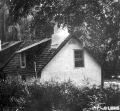
By the time this c. 1920 photo was taken, a plaque had appeared at that peak, but the logs were gone.
Roberts Marries. In 1690 at Haverford Meeting, John Roberts, "bachelor of Wain," believed to be 60 years of age, married Elizabeth Owen, said to be 18, an age difference not uncommon in those days. As Welsh settlers traditionally built more substantial homes when they married, it is now thought that Roberts built a typical Welsh 1-1/2 story stone house, c. 1690, on a hillside near the mill.
John Roberts sired four children. Roberts’ wife might have died in childbirth in 1699, the reason that no mention of her was made in his will of 1704, the year he died.
John Roberts II. John and Elizabeth’s eldest son, John, took title to his inheritance in 1716 and he married Hannah Lloyd in 1720. Sadly, this young man "sound of mind and memory, but frail of body," died a year later...four months before the birth of their son, also named John.
John Roberts III. It was this John Roberts who became very prosperous and active in community affairs as the Revolutionary War approached. Roberts III inherited his property in 1742. A year later, he married Jane Downing and, over the next 25 years, fathered twelve children, of whom ten survived past infancy.
Roberts III amassed extraordinary
holdings of over 700 acres. Records show that he owned mills and land
in neighboring townships and, with partners, had other mills in
Maryland.

A recent photo of the John Roberts House, at the corner of Old Gulph Road and Dodds Lane. It is now believed the earliest section (front left) was built by the first John Roberts when he married in 1690. In 1752, his grandson, John Roberts III, created the addition (front right) which originally had pent eaves and a balcony over the front door. The roof of the c. 1690 section was raised c. 1905 and the rooms of the house, which had become derelict, were rearranged.
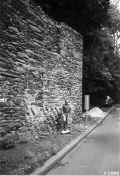
In 1999, the Township received a grant for stabilization of this last fragment of the Roberts mill wall beside Old Gulph Road. Joe Forrest, a master stonemason, recently completed the arduous work.
A New Mill. By 1746, the year he replaced the earlier mill of his grandfather, Roberts had a virtual monopoly on milling in Lower Merion. His mills made flour, lumber, paper, oil and gunpowder. Also, he owned orchards, woodland and watered meadows for his abundant livestock. He would have employed many workers and servants.
An Enlarged Residence. In 1752, John and Jane Roberts built a fine 3-1/2 story addition to the small stone dwelling of his grandfather. It boasted large windows, pent eaves and a balcony sheltering the front door. The original datestone, inscribed "J&JR 1752," is beneath its east peak. The earlier, c. 1690 house, likely one room with a loft, then became the kitchen, possibly also housing servants. Some dozen rooms held fine furnishings and the necessities of daily living. This manor house, overlooking Mill Creek, was a lovely setting for a family of privilege.

Across Old Gulph Road from the last fragment of the John Roberts mill on Mill Creek in Gladwyne, this double house was built in two stages. The original house, recessed to the right, was built c. 1790 for a miller after Roberts; the left section was added c. 1820-1840.
Activism. John Roberts III became a highly respected citizen in the greater community. A Quaker, he was named a trustee in 1763 for purchasing land for the Merion Meeting. By 1758 he had become active in public affairs. Roberts was appointed to a commission overseeing improvement of the Schuylkill River in 1760 and 1773. In 1774 he became a member of the Committee of Correspondence to protest the British government’s Port Bill. In 1775, in opposition to the slave trade, he was a delegate to the Convention for the Province of Pennsylvania.
Unsettling Times. In the years leading up to the Revolutionary War, increasing desire for independence from Britain spurred political maneuverings and personal jealousies. It was a trying time for Quakers; an affluent minority group which opposed war. In late 1777, predominently Quaker Lower Merion was overrun by foraging parties of both the British and American armies, sent to ransack farms and mills for provisions. John Roberts, miller, sustained the greatest losses.
Roberts’ Imprisonment. By 1777, Roberts had received frequent threats "by some malicious Persons in my Neighborhood" claiming he was a Tory. Denying any involvement, he fled to British held Philadelphia for safety.
Roberts later wrote that American soldiers then appeared at his "Plantation," threatened and abused his family and stole 64 animals. He said he intended to return home but his family, "who thought my Life in Danger, deterred me."
While in Philadelphia, Roberts helped imprisoned Americans and did other good deeds. He wrote of threats and abusive treatment by the British army.
At some point he was forced to guide British soldiers on foraging raids in Lower Merion...his only assistance to the British.
Roberts surrendered to the Americans after the British left Philadelphia. On June 19 he affirmed allegiance to the state. It is thought that he aided George Washington about this time by informing him of pending British movements.
Nevertheless, on July 27, based on oaths of neighbors, the Smiths, with whom he purportedly had a land dispute, a warrant was issued for Roberts’ arrest. The charges: high treason.
Perhaps Roberts expected acquittal based on his many good works. But he was arrested with others on August 10 and jailed in the Walnut Street prison. Only Abraham Carlisle and John Roberts were made to stand trial, rapidly convicted and sentenced to die by hanging.
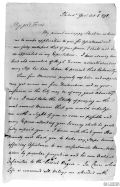
Portions of a letter written by John Roberts III as he awaited execution. Even from jail, while pleading for help, he tried to aid others.
Public Protests. An outcry followed. Petitions were sent to the Supreme Executive Council seeking a stay of execution and leniency for Roberts. The nearly thousand names included prominent Friends, 26 military officers and three signers of the Declaration of Independence.
The entire jury on his trial favored a stay; even Chief Justice Thomas McKean, who presided at Roberts’ trial and vehemently denounced him, asked postponement. Roberts’ children and wife pleaded on their knees for his life.
But the Council was adamant. John Roberts was executed on November 4, 1778.
Lingering Questions. It is said that Roberts’ hanging was "political murder"...he was made an example to discourage loyalists. Certainly he was put to death on slight charges. Interestingly, pertinent documents, including Justice McKean’s notes of the trial, were soon "missing."
All of Roberts’ estate was confiscated except those items his widow could prove were in her dowry. Its dispersal suggests ulterior motives, too. Four days after purchasing the property, Edward Milner quietly sold it to John Nesbitt and his two partners. Well-known to Justice McKean, the three were advocates of the Revolution. Roberts’ estate would seem a coveted "reward."
By 1792, an act was passed returning to Jane Roberts any unsold portions of Roberts’ estate and giving her a small pension.
John Roberts’ religious beliefs, great wealth and attempts to hold a middle course in the war probably led to his persecution and death.
Roberts best described his plight in his sad description of himself as "an unfortunate Man, born down by popular prejudice."

A view of the Roberts House from the hillside across Dodds Lane. The garage (at left) might have been a springhouse.

The dining room is in the original section of the house. The present owners greatly simplified the interiors to reflect the Quaker origins of the house, yet comfortable for 20th century living.
| <-- Previous | LMHS Home | Contents | Order Book | Next --> |